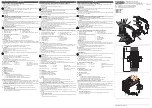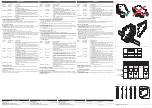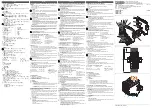
Caractéristiques techniques
Technical data
Technische Daten
Type
Type
Typ
CAPAROC PM PN
CAPAROC ...
Tension de service
Operating voltage
Betriebsspannung
10 V DC ... 30 V DC
Courant de référence I
N
Courant total entrée
Rated current I
N
Total current input
Bemessungsstrom I
N
Gesamtstrom Eingang
45 A DC
Température ambiante (fonctionnement)
Ambient temperature (operation)
Umgebungstemperatur (Betrieb)
-30 °C ... 50 °C
-30 °C ... 65 °C
Température ambiante (stockage/transport)
Ambient temperature (storage/transport)
Umgebungstemperatur (Lagerung/Transport)
-40 °C ... 70 °C
IN+;IN–
24-12
0,25-4
10
Signals
20-8
18
0,5-16
AWG
[mm²]
OUT+/–
24-16
8
0,2-1,5
L [mm]
+
Load
Load
Load
Load
12/24V
power supply
Connection point/
control signals
CB-module ...
...
3...
Signal and
control unit
Power module
IN+
IN–
1.0
Control
unit
CB-module 1
Protected
OUT+
3.1
Control
unit
CB-module 2
Protected
OUT+
3.2
Control
unit
CB-module x
Protected
OUT+
3.x
+
-
2.0
Distribution Current-Rail
12,4
12,4
6,2
6,2
24,8
111,3
132,4
PM PN
PD 0V
E1
E2
E4
6.1 Optische Signalisierung
7 Programmieren (2-Kanal Schutzschalter)
•
Schalten Sie den Kanal durch Drücken des zugehörigen LED-Tasters ein.
•
Stellen Sie den erforderlichen Nennstrom über den Drehschalter ein. Die Kanal-LED fängt an grün zu blin
-
ken.
•
Drücken Sie den Kanaltaster >2 Sekunden, um den neuen Stromwert zu speichern.
HINWEIS: Erstprogrammierung
Nach dem Einschalten des Kanals kann es dazu kommen, dass der Kanal abschaltet und die LED rot blinkt.
•
Stellen Sie den Nennstrom über den Drehschalter im ausgeschalteten Zustand ein. Die LED blinkt nun rot/
grün.
•
Drücken Sie den Kanaltaster >2 Sekunden, um den neuen Stromwert zu speichern.
HINWEIS: Nennstrom-Assistent
•
Programmieren Sie den Kanal auf den höchsten Wert (z. B. 10 A).
•
Nehmen Sie die Anlage in Betrieb, sodass der Betriebsstrom fließt.
•
Drehen Sie den Drehschalter schrittweise herunter, um sich dem aktuell fließenden Betriebsstrom zu nä
-
hern und somit den geeigneten Einstellwert des Kanals zu finden. Hierbei blinkt die Kanal-LED grün.
Wenn die Kanal-LED nach gelb/grün blinkend wechselt, so ist der gewählte Einstellwert für den aktuell flie
-
ßenden Anlagenstrom zu gering.
•
Drehen Sie den Stromwahlschalter wieder um eine Stellung hoch.
•
Drücken Sie den Kanal-LED Taster >2 Sekunden, um den neuen Stromwert zu speichern.
7.1 Optische Signalisierung
8 Warten und Reparieren
Das CAPAROC-System ist wartungsfrei. Reparaturen sind nur durch den Hersteller durchführbar.
9 Lizenzhinweise
Dieses Gerät verwendet Open Source Software: Apache 2.0, MIT Lizenz, 3-Klausel-BSD-Lizenz, Font Awe
-
some Free License.
Weiterführende Informationen finden Sie unter www.phoenixcontact.net/products im Downloadbereich und im
Web-based Management (WBM).
aus
LED aus
Kanal ausgeschaltet
grün
leuchtet
Kanal eingeschaltet
gelb
leuchtet
Kanal eingeschaltet, Kanalauslastung > 80 % des eingestellten
Nennstroms.
Überprüfen Sie die Konfiguration
blinkt
Kanal befindet sich im Programmiermodus
rot
leuchtet
Kanal ausgeschaltet, Überlast- oder Kurzschlussauslösung, Abkühl
-
phase von 5 Sekunden.
Einschalten des Kanals ist nicht möglich, solange die LED leuch
-
tet.
blinkt
Kanal ausgeschaltet, Überlast- oder Kurzschlussauslösung.
Schalten Sie den Kanal durch Drücken des zugehörigen LED-Tas
-
ters wieder ein.
rot/gelb
blinkt
Kanal befindet sich im Überlastmodus und wird in ca. 5 Sekunden ab
-
geschaltet.
Überprüfen Sie die Konfiguration.
aus
LED aus
Kanal ausgeschaltet
grün
leuchtet
Kanal eingeschaltet
blinkt
Kanal eingeschaltet, Programmiermodus ist aktiv und der eingestell
-
te Nennstrom weicht vom gespeicherten Wert ab.
Drücken Sie 2 Sekunden lang den Kanal-LED-Taster, um den ein
-
gestellten Nennstrom zu speichern oder stellen sie den Drehschalter
wieder auf den alten Wert zurück. Der alte Wert ist eingestellt, wenn
die LED nicht mehr blinkt.
gelb
leuchtet
Kanal eingeschaltet, Kanalauslastung > 80 % des eingestellten
Nennstroms.
Überprüfen Sie die Konfiguration
rot
leuchtet
Kanal ausgeschaltet, Überlast- oder Kurzschlussauslösung, Abkühl
-
phase von 5 Sekunden.
Einschalten des Kanals ist nicht möglich, solange die LED leuch
-
tet.
blinkt
Kanal ausgeschaltet, Überlast- oder Kurzschlussauslösung.
Schalten Sie den Kanal durch Drücken des zugehörigen LED-Tas
-
ters wieder ein.
rot/grün
blinkt
Kanal ausgeschaltet, Programmiermodus ist aktiv und der Nenn
-
strom wurde nach einer Abschaltung aufgrund eines Fehlers am
Drehschalter verstellt.
Speichern Sie den neu eingestellten Nennstrom indem Sie 2 Se
-
kunden lang den Kanal-LED-Taster drücken oder stellen sie den
Drehschalter wieder auf den alten Wert zurück. Der alte Wert ist ein
-
gestellt, wenn die LED nur noch rot blinkt.
gelb/rot
blinkt
Kanal befindet sich im Überlastmodus und wird in ca. 5 Sekunden ab
-
geschaltet.
Überprüfen Sie die Konfiguration.
6.1 Signalisation optique
7 Programmer (disjoncteur de puissance à 2 canaux)
•
Appuyer sur le bouton LED correspondant pour activer le canal.
•
Régler l'intensité nominale nécessaire avec le commutateur rotatif. La LED du canal commence à clignoter
en vert.
•
Appuyer sur la touche de canal pendant >2 secondes pour enregistrer la nouvelle valeur d'intensité.
REMARQUE : première programmation
Lorsque le canal a été activé, il arrive qu'il se désactive et la LED clignote alors en rouge.
•
Régler l'intensité nominale avec le commutateur rotatif à l'état désactivé. La LED clignote à présent en
rouge/vert.
•
Appuyer sur la touche de canal pendant >2 secondes pour enregistrer la nouvelle valeur d'intensité.
REMARQUE : Assistant intensité nominale
•
Programmer le canal sur la valeur la plus élevée (par ex. 10 A).
•
Mettre l'installation en service de sorte que le courant de service circule.
•
Abaissez pas à pas la valeur réglée du commutateur rotatif pour approcher la valeur actuelle du courant de
service circulant et trouver ainsi la valeur de réglage adéquate du canal. La LED du canal concerné clignote
en vert.
Si la LED du canal concerné se met à clignoter en jaune/vert, cela signifie que la valeur de réglage choisie
pour le courant circulant dans l'installation est insuffisante.
•
Régler à nouveau le sélecteur de courant d'une position vers le haut.
•
Appuyer sur le bouton LED du canal pendant plus de 2 secondes pour enregistrer la nouvelle valeur d'in
-
tensité.
7.1 Signalisation optique
8 Entretien et réparation
Le système CAPAROC ne requiert aucun entretien. Seul le constructeur est autorisé à effectuer des répara
-
tions.
9 Mentions relatives à la licence
Cet appareil utilise un logiciel Open Source Apache 2.0, MIT licence, licence BSD 3 clauses, Font Awesome
Free Licence.
Des informations complémentaires sont disponibles à l'adresse www.phoenixcontact.net/products dans la
zone de téléchargement et dans le système de gestion basée sur le web (WBM).
désactivé
LED éteinte
Canal désactivé
vert
allumé
Canal activé
jaune
allumé
Canal activé, charge du canal > 80 % de l'intensité nominale réglée.
Contrôler la configuration
clignote
Le canal se trouve en mode de programmation
rouge
allumé
Avec le canal désactivé, déclenchement d'une surcharge ou d'un
court-circuit, phase de refroidissement de 5 secondes.
L'activation du canal est impossible tant que la LED reste allumée.
clignote
Canal désactivé, déclenchement d'une surcharge ou d'un court-cir
-
cuit.
Appuyer sur le bouton LED correspondant pour réactiver le canal.
rouge/jaune
clignote
Le canal se trouve en mode surcharge et sera désactivé dans environ
5 secondes.
Vérifier la configuration.
désactivé
LED éteinte
Canal désactivé
vert
allumé
Canal activé
clignote
Avec le canal activé, le mode programmation est actif et l'intensité no
-
minale réglée diffère de la valeur enregistrée.
Appuyer pendant 2 secondes sur le bouton LED de canal afin d'en
-
registrer l'intensité nominale ou régler à nouveau le commutateur ro
-
tatif sur la valeur précédente. L'ancienne valeur est réglée lorsque la
LED a cessé de clignoter.
jaune
allumé
Canal activé, charge du canal > 80 % de l'intensité nominale réglée.
Contrôler la configuration
rouge
allumé
Avec le canal désactivé, déclenchement d'une surcharge ou d'un
court-circuit, phase de refroidissement de 5 secondes.
L'activation du canal est impossible tant que la LED reste allumée.
clignote
Canal désactivé, déclenchement d'une surcharge ou d'un court-cir
-
cuit.
Appuyer sur le bouton LED correspondant pour réactiver le canal.
rouge/vert
clignote
Avec le canal désactivé, le mode programmation est actif et l'intensité
nominale s'est déréglée après la désactivation en raison d'une erreur
survenue sur le commutateur rotatif.
Appuyer pendant 2 secondes sur le bouton LED de canal afin d'en
-
registrer l'intensité nominale nouvellement réglée ou régler à nou
-
veau le commutateur rotatif sur la valeur précédente. L'ancienne
valeur est réglée lorsque la LED ne clignote plus qu'en rouge.
jaune/rouge
clignote
Le canal se trouve en mode surcharge et sera désactivé dans environ
5 secondes.
Vérifier la configuration.
6.1 Optical signaling
7 Programming (2-channel circuit breaker)
•
Switch the channel on by pressing the associated LED button.
•
Set the necessary nominal current via the rotary switch. The channel LED starts to flash green.
•
Press and hold the channel button for >2 seconds to store the new current value.
NOTE: initial programming
After the channel has been switched on, it may occur that the channel shuts off and the LED blinks red.
•
Set the nominal current via the rotary switch while it is switched off. The LED now blinks red/green.
•
Press and hold the channel button for >2 seconds to store the new current value.
NOTE: nominal current assistant
•
Program the channel to the highest value (e.g. 10 A).
•
Start up the system so that the operating current flows.
•
Turn the rotary switch down step-by-step so that it approaches the operating current that is currently flowing
in order to find the appropriate setting for the channel. The channel LED flashes green in the process.
If the channel LED changes and starts to flash yellow/green, the selected setting is too low for the system
current that is currently flowing.
•
Turn the current selection switch back to one setting higher.
•
Press the channel LED button for > 2 seconds to store the new current value.
7.1 Optical signaling
8 Maintenance and repair
The CAPAROC system is maintenance-free. Repairs may only be carried out by the manufacturer.
9 License information
This device uses open-source software: Apache 2.0, MIT license, 3-clause BSD licence, Font Awesome free
license.
You will find further information at www.phoenixcontact.net/products in the download area and in the web-
based management (WBM) system.
off
LED OFF
Channel switched off
green
lit
Channel switched on
yellow
lit
Channel switched on, channel load > 80% of the nominal current set
-
ting.
Check the configuration
flashing
Channel is in programming mode
red
lit
Channel switched off, overload or short-circuit release, 5-second
cool-down phase.
It is not possible to switch the channel on while the LED is illumi
-
nated.
flashing
Channel switched off, overload or short-circuit release.
Switch the channel back on by pressing the associated LED but
-
ton.
red/yellow
flashing
Channel is in overload mode and will be switched off in approx. 5 sec
-
onds.
Check the configuration.
off
LED OFF
Channel switched off
green
lit
Channel switched on
flashing
Channel switched on, programming mode is active, and the nominal
current setting differs from the saved value.
Press the channel LED button for 2 seconds to save the nominal
current value setting or reset the rotary switch to the previous value.
The previous value has been set once the LED stops flashing.
yellow
lit
Channel switched on, channel load > 80% of the nominal current set
-
ting.
Check the configuration
red
lit
Channel switched off, overload or short-circuit release, 5-second
cool-down phase.
It is not possible to switch the channel on while the LED is illumi
-
nated.
flashing
Channel switched off, overload or short-circuit release.
Switch the channel back on by pressing the associated LED but
-
ton.
red/green
flashing
Channel switched off, programming mode is active, and the nominal
current was adjusted after a shut-down caused by a fault in the rotary
switch.
Save the newly set nominal current by pressing the channel LED
button for 2 seconds or reset the rotary switch to the previous value.
The old value has been set once the LED only blinks red.
yellow/red
flashing
Channel is in overload mode and will be switched off in approx. 5 sec
-
onds.
Check the configuration.
DEUTSCH
ENGLISH
FRANÇAIS
© PHOENIX CONTACT 2022
























